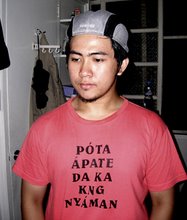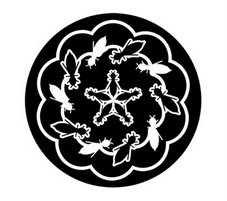The Unknown Kapampangan Laman Labuad
Writing about Apung Monang or Simeona “Monang” Calma-Matsdairo—the zarzuela-acting sister of my maternal grandfather and she who got married with a Japanese man (an actual heir to a Japanese royalty of the Matsdairo clan) at the age of 14 during the Japanese occupation—in my previous article about Teatru Ima at Arti, I was reminded that she’s to some degree psychic, so said my Ima.
Apung Monang as a lady demonstrated her psychic skills by casually addressing creatures of otherworldly dimensions. She would point to fairies and elves in a very relaxed manner, as if just pointing at ants lined on the wall. Of course, she would freak out people around her, including Ima, whose fear of the unknown is amplified by her typical Catholic senses—anything paranormal should be diabolic in nature.
My Limited Memory
Apung Monang and her little brother, Apung Marcial (Marciano Lansang Calma), who is my maternal grandfather and a former soldier during the American-Japanese War, slept in the same room when they grew up, along with my grandmother, Apung Ines (Ines Lagman-Calma). We were already living in Angeles then and by the time I was growing up as a toddler, Apung Monang and Apung Marcial were already somewhat senile.
Apung Marcial often rested beneath our thorny anahaw plant in the middle of our garden. Wounds would line up on his skin and he wouldn’t care, thanks to his senility. Having attachment to his hometown Porac where he became tinyente in one of the barangays, he occasionally walked out from the house without warning and kept on proclaiming he wanted to return to Porac. As a mischievous kid, I would offer him a medium-sized block of Lego and tell him it’s bread. He would try to eat it only to discern it’s as hard as rock. I then would laugh at his conclusion: “E la tinape reni, kendi la.”
Apung Monang was more of the silent type, as even though she was already senile, she just laid still in her bedroom. In fact, I have no special memory of her; all the tales about her, including her marriage with an heir to some royal Japanese family, are all thanks to Ima’s storytelling.
When Apung Marcial died, the family didn’t want to tell Apung Monang at once because she might grieve a great deal, and it could be jeopardous to her health. But when my aunt came to visit her—surprise!—she was already grieving because she already knew what occurred. How? According to Apung Monang, a certain white figure—an angel or something—approached her and delivered the report. My aunt’s hair raised.
The Sakondu
One of the laman labuad (elementals) that Apung Monang used to claim to be seeing is an elemental she and a lot of my Poraqueño relatives call the sakondu. How it looks like, I still have no idea. I consulted several sources, including Kapampangan historians, folklorists, and other authorities of so-called Kapampangan culture, but none of them could shed light on what a sakondu is.
In one of my recent visits to the spiritists of Jalung, Porac, I asked a relative, Apung Asing, about the sakondu. She knew that it was an elemental, but she couldn’t characterize it for me. All she knew was that, like the popular kapri, duendi, and magkukutud, the sakondu was also used by folk elders to scare children to submission. “Oyan na ing sakondo!” elders would threat.
Out of curiosity, I tried to play researcher for a bit. Sakondu actually sounds like a Spanish word. I searched its possible origin—sacondo or secondo—through the Internet and it (secondo) appears to actually be an Italian word, and it has a very interesting meaning.
Indigenized
According to a short definition from Wikipedia, secondo is a term of Italian origin used in the German speaking areas of Switzerland to denote someone who is the child of immigrants. Because of conservative Swiss citizenship law, these children are often unable to become citizens and may feel marginalized.
In an article by N. D. Schäfer at www.italianrap.com, he reports that people of foreign descent born in Switzerland don’t automatically get a Swiss passport; they are still seen as different from the Swiss natives. The author further explains, “There’s even a term for them: secondo (for females: seconda), a term used only in the German-speaking part of Switzerland even though clearly Italian. The sons and daughters of secondos and secondas are called terceros and terceras (from Spanish).”
I am reminded of the theory about the origin of the term kapri, a more popular local folklore character. Some say that it could have been from kaffir, a word brought by the Europeans in our archipelago which they use to address black southern Africans. From the Arabic word kafir, it originally means heathen, infidel, or non-believer. To further demonize the concept, the Spaniards could have propagated a more monstrous image of a kaffir, and hence, our paranormal fear of the kapri, which physically speaking resembles the general physique of a tall African man, only ornamented with frightening features like inflicting harm or sickness on people, tobacco-smoking, tree-dwelling, and others.
Now, could it be possible that the idea of the sakondu came from the Europeans’ secondo as well? That the concept was flavored with horror in our lands for them to institutionalize in our virgin minds this ethnic slur toward what they consider “second-class citizens” or secondos in their part of the world?
It could be. Devout Kapampangan researchers may look into this theory more.
A meaningful All Souls’ Day to everyone!
Alben meng manyaman, boy!
November 15, 2008
Ing Sakondu
Amanung susi:
Cross-Ethnic,
History,
In Action,
Language,
Personalities,
Psychology,
Vocabulary
Subscribe to:
Post Comments (Atom)








1 comment:
Awesome blog. I enjoyed reading your articles. This is truly a great read for me. I have bookmarked it and I am looking forward to reading new articles. Keep up the good work. Let make your blogs more plentiful on instagarm with site webstagram
Post a Comment